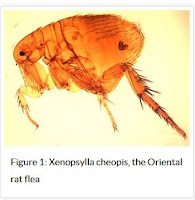
Credit CDC
#18,389
Later this week (Thursday 3/27) the CDC will hold their first COCA Call Webinar of 2025 - presentations which are primarily geared for clinicians and public health workers - that will deal with the re-emerging threat of Murine Typhus in the United States.
While it doesn't threaten public health on the scale of zoonotic influenza, eighty years ago it was endemic in parts of the United States, causing thousands of infections each year during the 1930s and 1940s.
Not to be confused with Typhoid Fever - which is caused by a Salmonella Typhi infection that can (rarely) be transmitted from one person to another - Murine Typhus is acquired from contact with infected fleas that live on rodents, possums, raccoons and cats.
Through the use of vector control methods (including liberal use of DDT during the 1950s and 1960s), the number of cases dropped from > 5400 in 1944 to less than 100 in 1956 (cite). By 1987, incidence had dropped low enough that Murine Typhus was no longer a reportable disease (see chart below).
But over time, DDT lost much of its effectiveness - and was eventually banned in 1972 for environmental reasons - which coincidentally was the year with the lowest case count (n=18). While cases remained low well into the early 2000s, the lack of reporting requirements likely affected the numbers.
In recent years - particularly in Texas - we've seen a resurgence of murine typhus (see 2017's Texas: DSHS Issues Murine Typhus Alert), with Texas DHHS currently reporting:
Over 5,800 cases of flea-borne typhus were reported between 2008 and 2022 [max = 738 cases/year (2018); min = 135 cases/year (2010)] (PDF). Approximately 70% of the cases were hospitalized and 13 cases were fatal.
Details on this week's COCA call follow. These presentations are often technical, and are of greatest interest to clinicians and healthcare providers, but are also archived and made available to the general public.
Murine Typhus: A Re-emerging Threat in the United States
At a glance
During this COCA Call, presenters will review the epidemiology, diagnosis, and treatment of murine typhus, and discuss its re-emergence in the United States.
Webinar
Thursday, March 27, 2025
2:00-3:00 P.M. ET
Dial-in Information:
Please click this link to join the webinar:
Webinar ID: 161 118 8659
Passcode: 974389
Or One tap mobile: +16692545252,,1611188659#,,,,*974389# US (San Jose)
Or Telephone:
+1 646 828 7666 US (New York)
Webinar ID: 161 118 8659
Passcode: 974389
Overview
During the 1930s and early 1940s, thousands of cases of murine typhus, a potentially life-threatening, flea borne rickettsiosis caused by Rickettsia typhi, were reported annually across the southeastern United States. Beginning in the mid-1940s, cases declined drastically, due to wide scale sanitation and pest management strategies. However, during the last 25 years, murine typhus has re-emerged with a vengeance across multiple urban centers in the United States.
Several vertebrate species associated with urban and peri-urban habitats, including rats, opossums, and several species of fleas, contribute to the zoonotic transmission of R. typhi to susceptible human hosts. Murine typhus is treatable with antibiotics, and people who are treated early in the infection recover quickly. Severe disease that can include meningoencephalitis, myocarditis, hemophagocytic lymphohistiocytosis, or death may occur in people if treatment is delayed, or if the diagnosis is missed.
During this COCA Call, presenters will review the epidemiology, diagnosis, and treatment of murine typhus, and discuss its re-emergence in the United States.
Presenters
Johanna Salzer, DVM, PhD
Veterinary Medical Officer
Lead, Epidemiology Team
National Center for Emerging and Zoonotic Diseases
Centers for Disease Control and Prevention
Lucas Blanton, MD
Associate Professor of Medicine
University of Texas Medical Branch
Christopher D. Paddock, MD, MPHTM
Medical Officer
Lead, Microbiology and Diagnostic Team
National Center for Emerging and Zoonotic Diseases
Centers for Disease Control and Prevention

